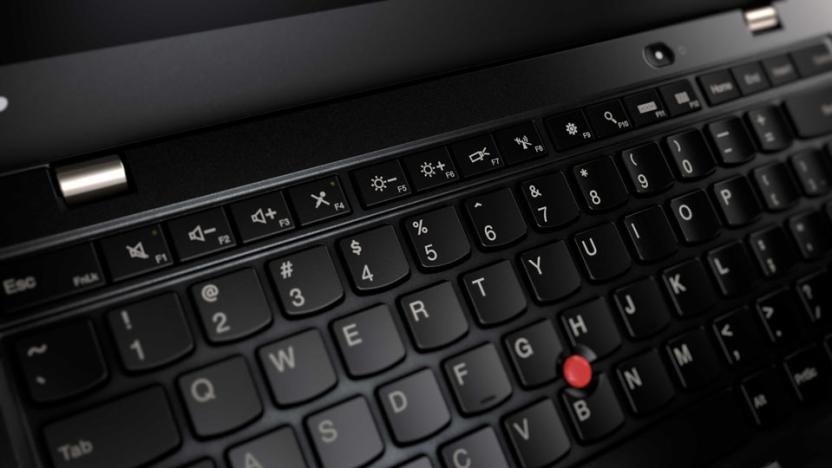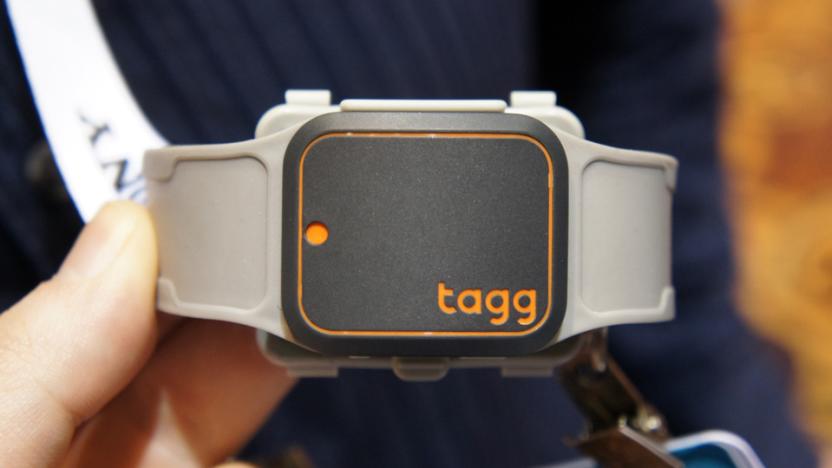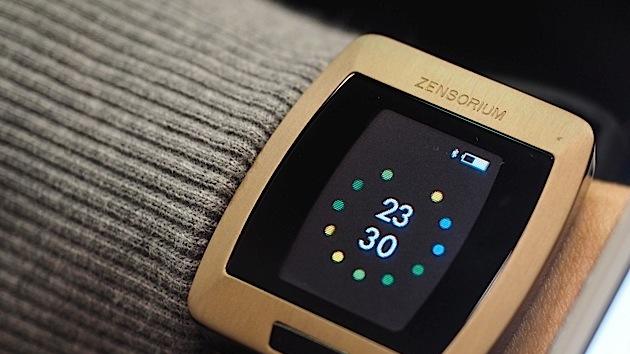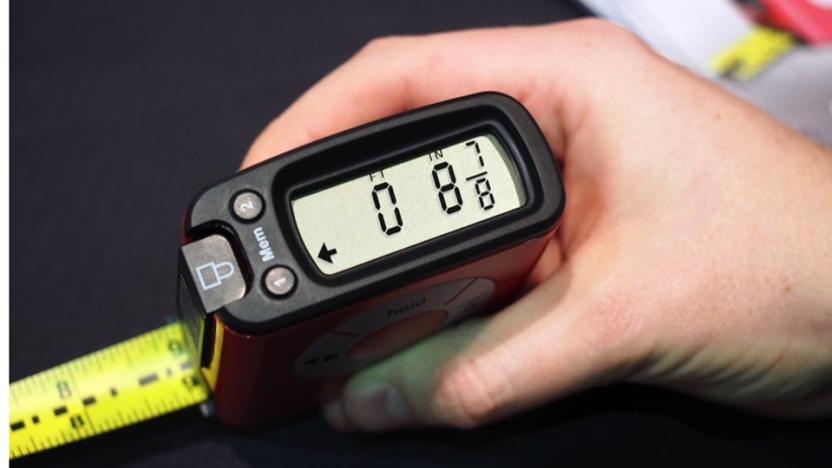ces2015
Latest

Lenovo's new laptop accessories are modular, stackable, weird
Docks, external hard drives and other laptop add-ons are supposed to make your life easier, but they can be a hassle if you have to carry more than one. Just ask any traveler unpacking a mess of boxes and wires if you need proof. Lenovo wants to get rid of this clutter as much as you do, so it's launching a rather oddball accessory system, the ThinkPad Stack, to simplify things a bit. The modular, magnetic design lets you pile peripherals on top of each other (complete with shared data and power) to save space and eliminate cabling -- think of it as a Voltron for road warriors. As quirky as that sounds, it makes sense in real-life situations. If you need both a wireless hotspot and a battery pack on your big business trip, for instance, you won't have to lug around two sets of cables to keep them powered up.

Lenovo's latest business Ultrabook does away with last year's unpopular design
You haven't known a fanboy until you've met a ThinkPad fan. The brand's loyal following (many of whom started as IBM users) can be very resistant to change. How resistant? Let's put it this way: Anytime the brand's current owner Lenovo so much as redesigns the touchpad, it does so at its own peril. That being said, Lenovo may have gone too far with last year's X1 Carbon. With the 2014 edition of its flagship business Ultrabook, Lenovo ripped out the physical Function buttons, leaving users with an "adaptive" panel whose touch-sensitive buttons changed depending on the task at hand. We weren't fond of it, and apparently real-world users weren't either: The company just unveiled the 2015 edition, and it brings back the physical function keys you all seemed to miss so much. Additionally, Lenovo undid some of the changes it had made to the touchpad. Whereas the last-gen model had a clickpad with zero buttons, this year's model returns the two right and left clickers that used to sit at the top of the pad -- the ones meant to be used with the signature red pointing stick.

Lenovo's new Windows app lets you enter handwriting in any text field
Look, we're not denying a pen can be a useful thing to have on a tablet. The problem is, it can be difficult to explain why you'd want one. You could circle things. You could doodle, if you had nothing better to do. You could obviously write stuff too, though you'd need to have open some sort of software that supports pen input. With a forthcoming app from Lenovo, though, you might be using your pen a little more often. The program, called WriteIt, taps into Win 8's accessibility layer, allowing you to enter handwriting in any text field, whether it be the built-in Windows search tool or the search bar on Engadget.com. Heck, you don't even have to color inside the lines, so to speak; it's OK if your handwriting extends beyond the boundaries of the text box. So long as your jottings at least begin in the box, WriteIt will use optical character recognition to decipher your handwriting, and serve up a list of suggested words you can tap.

Gymwatch's fitness strap can tell you when your reps are wrong
Doing a single exercise, like lifting a weight, is pretty easy. Doing an exercise well, on the other hand, is pretty hard. That's the idea behind Gymwatch, a fitness wearable that's designed both to tell you how many exercises you've done, but also if you've done any of them badly. After a successful Indiegogo campaign, the product is now ready for prime time -- almost.

Keep your pets from wandering off with Tagg and Alarm.com
You let the dog out into the garden while you pop back inside to get something. Next thing you know, she's gone. You knew you should have fixed up that gap in the fence. Too bad, huh? With Tagg, no longer would you have the anxiety of losing a pet. This "wearable" for pets claims to be able to locate your pooch (or cat) in almost all of America. How so? Well, there's GPS and connectivity through Verizon. That's how. So, as long as your mutt doesn't stray out of coverage, you'll be able to pinpoint his or her location. But Tagg's not just a one-trick pony/dog/cat. It's partnered with Alarm.com (makers of a full suite of smart home equipment) to add a bunch more functionality, or what the two companies are calling "smart pet tracking."

Dacor's Android-based ovens take voice commands from an app
We don't often write about ovens here, but when we do, we tend to come back to a brand called Dacor. Here at CES 2015, the 50-year-old company announced that it's adding voice activation to the phone and tablet app for its Discovery iQ Android-powered ovens plus ranges -- and we're looking at a base price of $8,999. While the existing app already comes with a remote control feature (including temperature, cooking mode and oven lights) plus recipe browsing, the new voice control saves you the hassle of tapping buttons, so long as your phone or tablet is on the same WiFi network as your oven.

When fingerprint scanners are hidden in your trackpad, you'll want one
Fingerprint scanners are coming to laptops. Again. Thanks, in part, to smartphones making them, if not quite cool, then useful. Synaptics, the laptop trackpad maker, already told us all about SecurePad, a touchpad with a fingerprint sensor built into the upper-left corner, and now look! Here it is! While the sensor built into the prototype laptop had a raised outline, Synaptics also told us that, heck, it can make it look like anything a hypothetical PC maker wants -- even if that means making it indistinguishable from the "main" trackpad. Since last month, laptop manufacturers have been able to start embedding the tech into their PCs, although which company will strike first with the sensor remains a mystery.

Zensorium's 'Being' is a fitness wearable that promises to track your mood as well
We've seen wearables that track our heart rate, activity levels and sleep patterns, but rarely do we see one that tracks our mood as well. That's the idea behind Zensorium's Being, a wearable that promises to not just monitor the usual activity tracker data such as NREM and REM sleep, heart rate, steps, calories burnt, distance and speed, but also your mood.

BeeWi takes on Belkin's WeMo with its new home automation platform
Not surprisingly, the Internet of Things is making a big splash here at CES 2015. As part of that push, BeeWi, a company better known for making various wireless products, is showing off its home automation platform. The BeeWi platform has been available in Europe, Canada and parts of South America for some time now, but the company announced that it's ready to bring it over to the US. In similar fashion to Belkin's WeMo line, BeeWi's home automation offerings include a mobile application and an array of modular sensors and trackers.

Use your feet to fly around a virtual world
Almost every time we've played around in virtual reality, be it of the Oculus Rift or Gear VR variety, we've had a game controller of some sort in our hands. It's necessary to navigate an environment, pop around and generally have a look about. The folks behind 3DRudder want to take that paddle and put it under your feet. At its simplest, the 3DRudder is an unobtrusive circular platform that replaces a D-pad on the controller. It's about 12 inches across and has a halved sphere underneath. Gyroscopes and accelerometers tucked inside track your movements via the pitch and yaw of your tootsies, and it connects to your computer via USB. According to the developers, the primary use they have in mind is for navigating 3D modeling programs like ZBrush or Maya, freeing your hands to switch brushes or change a tool while using feet to get around the scene you're making.

Parrot's Android-powered car system also does Apple CarPlay
Parrot's car infotainment systems may not be as well-known as its drones and audio products, but here's one that's worth paying attention to. The yet-to-be-named "RNB6" is a two-DIN unit that comes with a gorgeous 7-inch 720p "IPS Pro" touchscreen, along with a 4 x 55-watt audio amplifier and a wired wide-angle 1080p dash cam (with "Super HDR"). The device runs on a slightly customized version of Android 5.0 that offers media playback, navigation, telephony, dash cam, air control, parking assistance and onboard diagnostics (for tire pressure, parking sensors, air conditioning and more); as well as voice control for some of these features. Depending on the type of phone you plug in, the RNB6 can also toggle Apple CarPlay and Android Auto to let you control your phone via its own touchscreen.

'Smarter' TVs know what you're watching, react accordingly
TV manufacturers have labeled every one of this generation's internet-connected TV platforms "smart", but they don't always live up to the name. One reason is that the internet features can't interact with what you're watching, and are just simple add-ons. Cognitive Networks thinks it can fix that with tech that sees what you're watching, and pulls up related "interactive overlays" that fit. We've seen similar approaches before from companies like Yahoo, but while older tech did its snooping via closed captions, this one works by video fingerprinting the broadcast and identifying what's playing.

This Bluetooth thermometer patch could bring an end to infant ear violations
Since they don't yet have the power of speech, babies often have difficulty telling you when they're getting ill. For instance, if your munchkin starts running a fever in the night, you won't know about it until they start screaming, and sticking a probe into their ear won't make them very happy either. That's where TempTraq comes in, a thermometer in the form of a soft, stick-on patch that transmits your little one's vital signs straight to your smartphone.

Triby is a home WiFi phone (and wireless speaker) for your fridge
Just when you thought the home phone was dead and gone, Invoxia has come up with a new home for it: your refrigerator. Triby, which debuted at CES Unveiled tonight, is a little box that sticks to your fridge and lets you make free WiFi calls to anyone. And unlike the old, corded phone that lived in your kitchen decades ago, this one can also play music over Bluetooth (and it has an FM radio to boot). While it may seem kind of superfluous now that everyone (even many kids) has a smartphone of their own, Triby might be compelling to families who are always in the kitchen. You can also assign a few numbers to buttons on its front so kids can quickly ring mom and dad. Its e-ink screen lets it last for around seven months without a charge, and you can also send cute hand-drawn messages to the screen from the Triby app.

How much would you pay for a smart, safe home power outlet?
That is indeed the question, especially considering how inexpensive a standard, non-smart, non-"safe" power outlet is. This nice one from Home Depot costs under $10! What the outlet from Home Depot won't do for you, however, is tell you via smartphone app if it's being used, or which outlets in your house are being used. And it certainly won't kill the power when you're not using it; power outlets, sadly, may be constantly drawing power. If you've got anything plugged in to your standard outlet, even if it's not on, it might still be drawing power. That's both extremely inefficient and a waste of money. There's a company at CES 2015 that's aiming to change that, but what should it charge? Should it even make a "smart" power outlet, or just focus on the "safe" angle? That's still up in the air, but what it's got so far is worth knowing about.

Parrot Zik Sport headphones do noise canceling, heart monitoring
Parrot's Zik 2.0 noise-canceling Bluetooth headphones may not be ideal for workouts, but fans may want to give the new Zik Sport a spin to get a similar experience. Granted, these are actually in-ears instead of the earcup type, but Parrot and Philippe Starck still managed to tuck in eight microphones -- six for noise-canceling, two for voice calls -- in addition to a heart rate sensor, pedometers and a five-hour battery (and this is with all the features turned on). That's a very impressive package given how much smaller these headphones are.

We're still not sure what the point of ONvocal's 'hearable' device is
Way back in 2012, a study was conducted revealing that audiophiles were so tuned into their music that they stopped paying attention to the world around them, with fatal results. That's why there's been a trend for "safe" headphones that promise better audio quality while letting the ambient noise bleed in. ONvocal is hoping to take this trend one step further with the Mix360, a device that is one part Bluetooth headset and one part, er, something else entirely.

OnStar's new services save you money by watching how you drive
GM's cars are increasingly connected, and the automaker is coming up with some clever (if not always comforting) ways to put that data to use. Its OnStar badge has just unveiled a pair of services that promise to save you money if you're willing to share some of your driving activity. To start, it's launching an optional driver-assessment program in the US that studies your skills over 90 days and offers not only feedback, but also lower insurance rates (through Progressive) for good driving. In theory, this is a big incentive to drive responsibly, whether you're a newcomer or want to brush up on your road manners -- so long as you're fine with the car tracking your behavior, at least. You'll have to wait until the summer to give it a try, but it'll be available for all 2016 GM vehicles, most 2015 models and a handful of 2013 and 2014 cars.

The modern tape measure has instant metric conversions, optional Bluetooth
After an apparent seven-year hiatus, the electronic tape measure has returned... with a smartphone-era upgrade. If you don't see the screen, the E-Tape looks like any typical tape measure you'd find at Home Depot: a rubberized guard for the tape, a lock, and a hardy metal clip for attaching to your belt as you go about doing... buildery things. However, it does a few things more. Possibly the most convenient feature is the E-Tape's single-button press conversion: to inches, centimeters, inches with a decimal point, as well as distance in feet and inches. (Yay, no more thinking!)

InBody's new health band is all about measuring your body composition
Forget tracking your steps and sleep -- the next generation of wearables will have to do a lot more to get your attention. And that's a lesson InBody, a company that's been in the professional health-tracking market for over 20 years, is taking to heart. Here at CES, it unveiled the $179 InBody Band, one of the first wearables to focus on measuring your body composition (your body fat compared to your lean tissue). That's something Jawbone's upcoming Up3 band will be able to do as well, but InBody reps tell me its experience in the health market among professional athletes and gyms will give it a leg up when it launches in the first quarter.











